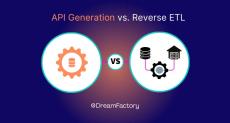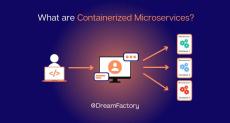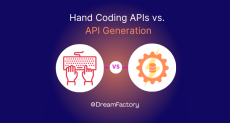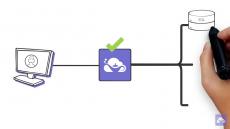|
By Spencer Nguyen
Legacy applications pose multiple problems for data-driven organizations like yours. Outdated software might no longer receive support and maintenance from its vendor or might not integrate with modern technologies like cloud computing. Still, these applications are essential for day-to-day business tasks, and replacing them could impede productivity and profitability.
|
By Kevin McGahey
We’re happy to announce that we’re consolidating all of our documentation into one easy to use site! Yep, we’re sunsetting the wiki and guide, and we’re moving it all to Docs.dreamfactory.com. This new site will be the go-to site for all technical documentation for DreamFactory.
|
By Terence Bennett
An API ecosystem refers to the interconnected network of applications, services, and APIs that collaborate to enable data exchange, functionality, and interactions between various software components. An API connects all the software developments so they can work together. Developers can connect apps that don’t normally work together, allowing for combined strengths and opportunities to close gaps in product capabilities.
|
By Terence Bennett
API generation, as implemented by DreamFactory, allows for direct, real-time access to data stored in Snowflake, while Reverse ETL typically involves moving data from the warehouse to operational systems in batches. Here are some specific examples and use cases for each approach.
|
By Jeremy H
Containerized microservices are essential to cloud migration and digital transformation plans. Do you have a clear picture of what containerized microservices are and why they’re important? In this guide, you'll learn about containers, microservices, and how they work together. First up is a bit of history that explains how the need for containers came to be. Here's the key things to know about containerized microservices.
|
By Jeremy H
Are you thinking about hand-coding an API? You have the perfect application in mind. It has an attractive UI and achieves everything the customer wants. However, it needs to connect with a Microsoft SQL Server database, so you have to start working on the data model and API. Hand coding APIs offers greater customization and control but is time-intensive, whereas API generation provides a faster, more streamlined approach with automated tools, albeit with less flexibility.
|
By Kevin McGahey
Nowadays, building robust and secure RESTful APIs is a fundamental task. However, developers often stumble upon a common challenge: Cross-Origin Resource Sharing (CORS) issues. These issues can hinder the integration of APIs from across different domains, leading to frustration and delays in development timelines. In this article, we’ll be discussing the intricacies of CORS, and figuring out why these security features are essential.
|
By Kevin McGahey
A SQL injection attack is an attempt to modify the syntax of a SQL query executed in conjunction with a user-initiated action within a software application. Some examples of user-initiated actions include searching for a product within an e-commerce catalog, adding a comment to a blog post, and creating a new user account. In each of these scenarios, the user uses a form to submit input (e.g.
|
By Jeremy H
If you’re at all familiar with APIs, you know that REST APIs are the main API used, particularly when it comes to microservices and their applications. gRPC is a high-performance, binary, and strongly-typed protocol using HTTP/2, while REST is a simpler, text-based, and stateless protocol using HTTP with JSON/XML.
|
By Spencer Nguyen
Application programming interfaces (APIs) do a lot of behind-the-scenes work that you might never notice. When you look at the weather forecast on your smartphone, you get updated info because of an API. You rely on APIs when you sign into your email account, get driving directions, and book airplane tickets.
|
By DreamFactory
In this video, we do a quick walkthrough of the DreamFactory platform and demonstrate how easy it is to generate a fully documented, secure Snowflake REST API.
|
By DreamFactory
In this video, we do a quick walkthrough of the DreamFactory platform and demonstrate how easy it is to generate a fully documented, secure SQL Server REST API.
|
By DreamFactory
DreamFactory excels at creating fully documented, secure REST APIs for any data source. In this video, we walk through just how simple it is to create a SQL Server API.
|
By DreamFactory
This video walks through the significant changes and improvements introduced in our platform's latest DreamFactory UI update. The update is designed to enhance user experience, improve usability, and provide a fresh and modern look and feel.
|
By DreamFactory
Check out this replay from API World 2023 featuring Terence Bennett, CEO of DreamFactory, diving into the disruptive world of API generation. In this session, Terence will guide you through the ins and outs of efficient API generation.
|
By DreamFactory
This video will show you how simple it is to set up a Microsoft SQL server using DreamFactory. Who we are: DreamFactory is an API generation solution for more than 20 databases and many other data sources. With DreamFactory you can connect to any data source and instantly access a full-featured, secure, and documented REST API for your projects. DreamFactory replaces months of API development and server-side integration work. Start your projects with reliable REST APIs from day one.
|
By DreamFactory
It shouldn't be difficult to create a REST API for your data sources. DreamFactory allows you to save months of manual coding and lets you connect your data sources quickly!
|
By DreamFactory
DreamFactory lets you create fully documented and secure REST APIs for any data source in a matter of minutes.
|
By DreamFactory
DreamFactory is a leading on-prem API generation and management platform built for data teams and backend developers to securely connect self-hosted and legacy systems and make them universally accessible. With DreamFactory, developers can connect nearly any database or data source with secure, compliant REST APIs in minutes instead of days.
|
By DreamFactory
This video will demonstrate how to quickly install DreamFactory on Ubuntu using the DreamFactory automated installer.
|
By DreamFactory
Containers and microservices are redefining the software development lifecycle. Developers are empowered to choose best of the breed languages, frameworks, and runtimes to develop software. DevOps teams are dealing with new packaging and deployment mechanisms. Container orchestration tools such as Docker Swarm, Kubernetes, Apache Mesos are changing the way applications are deployed and managed.
|
By DreamFactory
The exploding complexity of backend interfaces is a real problem for companies building mobile and web applications or just using REST API services.
|
By DreamFactory
Large enterprise and government organizations often inquire about how the DreamFactory REST API platform helps secure data access. Especially now that a growing number of web and mobile apps need to access sensitive data, and proper controls are imperative in the services used to access that data from an expanding number of apps.
|
By DreamFactory
DreamFactory is a configurable LAMP stack running PHP. As far as the server is concerned, DreamFactory looks like a website written in WordPress or Drupal. Instead of delivering HTML pages, DreamFactory provides JSON documents, but otherwise, the scaling requirements are similar.
|
By DreamFactory
Serverless Computing is considered to be the fourth wave of computing where x86 servers, virtual machines, and containers represented the first three generations. With this new paradigm, developers can squarely focus on the code and without the need to deal with the underlying infrastructure. They never have to plan the number of servers, amount of storage, and the network topology of deployments. Since the platform deals with one function at a time, and functions are the fundamental deployment units, this model is often called Functions as a Service (FaaS).
- November 2024 (3)
- October 2024 (9)
- September 2024 (11)
- August 2024 (11)
- July 2024 (14)
- June 2024 (8)
- May 2024 (8)
- April 2024 (13)
- March 2024 (11)
- February 2024 (13)
- January 2024 (18)
- December 2023 (8)
- November 2023 (8)
- October 2023 (15)
- September 2023 (12)
- August 2023 (14)
- July 2023 (10)
- June 2023 (10)
- May 2023 (5)
- April 2023 (6)
- March 2023 (6)
- February 2023 (8)
- January 2023 (9)
- December 2022 (8)
- November 2022 (3)
- October 2022 (6)
- September 2022 (7)
- August 2022 (12)
- July 2022 (7)
- June 2022 (7)
- May 2022 (9)
- April 2022 (10)
- March 2022 (13)
- February 2022 (13)
- January 2022 (14)
- December 2021 (5)
- November 2021 (8)
- October 2021 (8)
- September 2021 (7)
- August 2021 (9)
- July 2021 (11)
- June 2021 (10)
- May 2021 (16)
- April 2021 (10)
- March 2021 (12)
- February 2021 (14)
- January 2021 (13)
- December 2020 (15)
- November 2020 (5)
- October 2020 (2)
- September 2020 (4)
- August 2020 (3)
- July 2020 (4)
- June 2020 (11)
- May 2020 (10)
- April 2020 (8)
- March 2020 (2)
- February 2020 (3)
- January 2020 (3)
- December 2019 (4)
- November 2019 (4)
- October 2019 (4)
- August 2019 (5)
- July 2019 (1)
- May 2019 (1)
- March 2019 (1)
- February 2019 (1)
- January 2019 (1)
- June 2018 (2)
- April 2017 (1)
- March 2017 (1)
Never Build an API Again. An enterprise-grade API as a service platform available in the cloud or on-premise. Generate database APIs instantly to build applications faster.
Integrate any SQL or NoSQL database, file storage system, or external HTTP or SOAP service and DreamFactory instantly generates a flexible, comprehensive, and fully documented REST API endpoint that’s ready to use. Focus on building your applications, not hand-coding APIs for every new development project.
Benefits:
- Instant APIs without code. Eliminate the biggest bottleneck in modern IT. Launch your project in weeks rather than months. DreamFactory instantly creates a secure, standardized, reusable, fully documented, and live REST API.
- Manage your data portfolio. Connect Salesforce to SQL Server, or your ERP to AWS S3. Transform and mask data along the way. Create reports, analytics, and alerts. Empower teams to retrieve and distribute data on demand.
- Secure your data with layered controls. Secure every API endpoint with Role-Based Access Controls, SSO Authentication, JWT, CORS, OAuth, and Active Directory. Deploy behind firewalls and in air-gapped environments.
- Modernize legacy applications. Integrate legacy technology into cutting-edge applications, extending technology lifecycles and derisking legacy system replacements.
REST API Automation and API Management made simple.






















